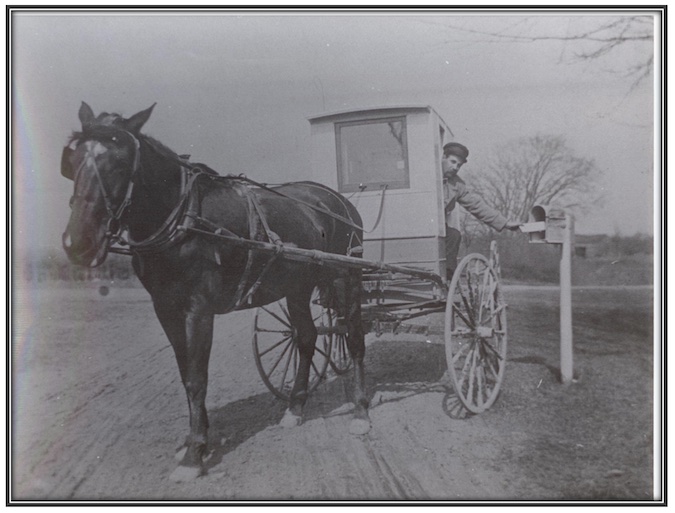Rural mail delivery arrived in Albion in 1900, after a wait for residents in the country
By Catherine Cooper, Orleans County Historian
“Illuminating Orleans” – Vol. 4, No. 3
Rural Orleans County residents have contended with lack of access to broadband service for some time, while their urban neighbors enjoy the advantages of high-speed internet connections.
But the urban-rural disparity in communications is not a new one – mail delivery experienced a similar issue from the 1860s to the early 1900s.
The Free City Delivery Act of 1863 mandated that free delivery of mail to individual homes be established at Post Offices where income from local postage was more than sufficient to cover the costs of providing the service. Before 1863, people were required to go to the post office to pick up their mail, as postage only paid for the delivery of mail from one post office to another.
The service proved to be very popular. Some urban areas even had mail delivery twice daily, this continued until 1950. Meanwhile, rural areas languished.
H. Justin Roberts, participant in the Oral History project, recalled:
“We had to go two miles to get our mail. That would be in East Shelby. In those days, East Shelby, Millville, Knowlesville and all those little places had their own postmark. In the wintertime, neighbors along our road used to take turns going down to East Shelby to get the mail. They would bring the mail up and leave it at each house along the way. Mail was brought up from Knowlesville by horse and buggy. It would have been delivered at the Knowlesville depot.”
Proponents of rural mail delivery argued that if the government provided mail delivery to urban areas, it should provide a similar service to rural residents.
Following several years of political disputation, Rural Free Delivery, a huge undertaking, was established in 1896 though it took some time to implement nationwide. Routes had to be established, carriers hired – 32,000 by 1905.
In Albion, Postmaster R. Titus Coan posted the following description of Rural Route 1:
Beginning on Saturday, December 1, 1900, the carrier will go south to the Albion waterworks standpipe; then west to Mason’s Corners, thence south to Sheldon’s Corners, thence west to Porter’s Corners, thence south to the end of the road; thence west to the Pine Hill Road; thence south to Standish’s Corners; thence west to D. Tower’s corners; thence southeast to West Barre post office; then south to Mull’s Corners; thence east to Hill’s Corners; thence north to Manchester’s Corners; thence east to Grinnell’s Corners; thence north and northeast to Bragg’s Corners; thence west to Wetherbee’s Corners; thence north on West Barre road to Miller’s Corners, thence east to Sanderson’s Corners; thence north to Snyder’s Corners; thence east to Bond’s Corners; thence north to Lee Road, east on Lee Road to Benton’s Corners, thence north to the Albion post office. (Democrat & Chronicle Nov. 26, 1900.
Homer C. Heady was the Albion carrier.
Carriers had to furnish their own wagons and horses and pay for their upkeep. They carried with them a supply of postage stamps, postal cards, stamped envelopes, newspaper wrappers and money order blanks.
They traversed their routes through all kinds of weather, on unpaved roads, six days a week for a salary of $600 ($21,000 approx.). They were finally excused from Christmas Day delivery in 1923.
Rural free mail delivery ended the isolation of rural residents. They could connect to the outside world daily through their mailboxes. They felt that they were finally getting the benefit of a government service. With the introduction of parcel post in 1913, they could shop from home. Sounds familiar.










































































